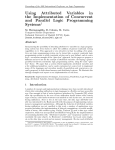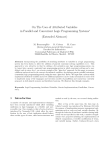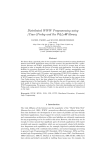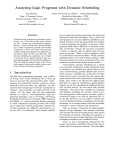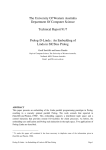Download Using Attributed Variables in the Implementation of Concurrent and
Transcript
Using A t t r i b u t e d Variables in
t h e Implementation of Concurrent
and Parallel Logic Programming
Systems
M. Hermenegildo, D. Cabeza, M. Carro
Computer Science Department
Technical University of Madrid (UPM), Spain
{herme,dcabeza,mcarro}@fi.upm.es
Abstract
Incorporating the possibility of attaching attributes to variables in a logic programming system has been shown to allow the addition of general constraint solving
capabilities to it. This approach is very attractive in that by adding a few primitives any logic programming system can be turned into a generic constraint logic
programming system in which constraint solving can be user deñned, and at source
level - an extreme example of the "glass box" approach. In this paper we propose a
different and novel use for the concept of attributed variables: developing a generic
parallel/concurrent (constraint) logic programming system, using the same "glass
box" flavor. We argüe that a system which implements attributed variables and
a few additional primitives can be easily customized at source level to implement
many of the languages and execution models of parallelism and concurrency currently proposed, in both shared memory and distributed systems. We illustrate this
through examples and report on an implementation of our ideas.
Keywords: Implementation Techniques, Concurrency Parallelism, Logic Programming, Attributed Variables, Generic Implementations.
1
Introduction
A number of concepts and implementation techniques have been recently introduced
which allow extending uniñcation in logic languages in a flexible and user-accessible
way. One example is that of meta-structures, introduced by Neumerkel [22], which
allow the speciñcation by the user of how uniñcation should behave when certain
types of terms, called meta-structures and marked as such by the user, are accessed
during uniñcation. More or less at the same time, the data type attributed variable was introduced by Le Houitouze [18] with the purpose of implementing various
memory management optimizations. Although the behavior of attributed variables
during uniñcation was not speciñed in this work, a number of applications were
proposed including the implementation of delayed computations, reversible modification of terms, and variable typing. Earlier, Carlsson [4] used a data type called
suspensión, which was incorporated into SICStus Prolog [5] for the implementation
of coroutining facilities [8]. "Attributed variables" and "suspensión variables" are
essentially the same objects. Le Houitouze's contribution was to put some emphasis on the data type as such and on memory management. He also used attributed
variables as a low level primitive for the implementation of mechanisms that necessitated the speciñcation of the behavior of the data type during uniñcation.
A reñned versión of the concept of meta-structures and attributed variables
was used by Holzbaur in [16] for the speciñcation and implementation of a variety
of instances of the general CLP scheme [19]. By enhancing the SICStus Prolog
system with attributed variables a generíc system is provided which is basically a
SICStus Prolog "clone" where the uniñcation mechanism has been changed in such
a way that the user may introduce interpreted terms and specify their uniñcation
through Prolog predicates. This approach is very attractive in that it shows that
by adding a few primitives any logic programming system can be turned into a
generic constraint logic programming system in which constraint solving can be
user deñned, at the source level - an extreme example of the "glass box" approach.
Another system which implements constraint solving using similar techniques is the
ECL ¿ PS e system developed at ECRC [11].
While this approach in principie has drawbacks from the performance point of
view (when fully interpreted up to an order of magnitude slowdown is possible w.r.t.
native CLP systems) the convenience and generality of the approach can make it
very worthwhile in many cases. Furthermore, the speed can be easily increased in
interesting cases by writing the uniñcation handlers in a lower-level language. The
potential for achieving both genericity and reasonable speed is illustrated by the
relatively good performance exhibited by the ECL*PSe system, which has been used
in many practical applications.
Inspired by the previously discussed use of attributed variables we propose a different and novel use for such variables in a completely different context: developing
generíc parallel/concurrent (constraint) logic programming systems, using the same
"glass box" flavor. Attributed variables have already been used to implement the
coroutining (delay) facilities present in many Prolog systems - often what is actually being done is in fact restoring such capabilities after having "cannibalized" the
delay mechanism support for implementing the attributed variables. However, we
argüe that a system which implements both support for attributed variables and a
few additional primitives related to concurrency and parallelism can do much more
than simply restoring the delay mechanism. In fact, it is our thesis that using the
primitives mentioned above it is possible to easily implement many of the languages
and execution models of parallelism and concurrency currently proposed. We illustrate this through examples and we discuss how quite complex concurrent languages
and parallel execution models can be implemented using only such primitives. Furthermore, we argüe that this can be done in a seamless and user-transparent way
in both shared memory and distributed systems. Also, one additional advantage of
our technique is that it relates and uniñes the two main approaches currently used
in concurrent logic programming, and which are seen traditionally as unrelated:
"shared variable" systems, in which communication among parallel tasks is done
through variables, and "distributed" or "blackboard" systems in which communication is done through explicit built-ins which access shared channels or global data
cirGcis.
It should be noted that the use that we propose of attributed variables in the
implementation of concurrency and parallelism does not necessarily prevent their
simultaneous use also for other purposes, such as the original one of constraint
solving. Also, note that the approach proposed, although having some similarities,
differs from that of "generic objects," recently and independently discussed by the
KL1 implementors [7]. The idea in generic objects is to provide an interface at the
"C" level for a particular class of extensions. Our approach differs in both the level
at which the extensions are made (which is completely at the source level in our
case, thus really offering a reflective, glass box approach), and the nature and extent
of the extensions proposed, which goes beyond those that are related to supporting
KL1.
Space limitations forcé the presentation to cover only some basic cases and give
incomplete descriptions of the implementations. For more details the reader is
referred to [14]. Also, the implementations described can be obtained by contacting
the authors.
2
Attributed Variables and Related Primitives
We provide a brief introduction to attributed variables. For concreteness, we follow a
stylized versión of Holzbaur's ñrst implementation of attributed variables in SICStus
Prolog. The reader is referred to [16, 17] for more detailed information.
2.1
General Concepts
Attributed variables are variables with an associated "attribute." Attributes are
terms which are attached to variables, and which are accessed in a special way during uniñcation and also through special built-in predicates. As far as the rest of a
given Prolog implementation is concerned, attributed variables behave like variables.
Special treatment for attributed variables does apply mainly during uniñcation: as
will be described later, when an attributed variable is to be uniñed with another
attributed variable or some other non-variable term, user-deñned predicates specify
how this uniñcation has to be performed. The following is a list of typical predicates which provide for the introduction, detection, and manipulation of attributed
variables. In general, attributed variable related operations are correctly undone
upon backtracking.
• get_attr(X,C): if X is an attributed variable, unify the corresponding attribute with C, otherwise fail.
• attach_attr(X,C): turn the free variable X into an attributed variable with
attribute C.
• detach_attr(X): remove the attribute from an attributed variable, turning it
into a normal variable.
Attributed variables are dealt with specially during uniñcation. Essentially, the
different possible cases are handled as follows. A uniñcation between an unbound
variable and an attributed variable binds the unbound variable to the attributed
variable. When an attributed variable is about to be bound during uniñcation
to a non-variable term or another attributed variable, the attributed variable and
the valué it should be bound to are collected. At the next inference step, the
pending attributed variable-valué pairs are supplied to user-deñned handlers which
are deñned by the user by means of the following predicates:
• v e r i f y _ a t t r ( C , T ) : invoked when an attributed variable with an attribute
which uniñes with C is about to be uniñed with the non-variable term T.
• combine.attr (Cl, C2): invoked when two attributed variables with attributes
Cl and C2 are about to be uniñed.
Note that the two predicates are not called with the attributed variables involved, but with the corresponding attributes instead. The is done for reasons of
simplicity and efñciency (e.g. indexing). Note also, however, that if access to the actual attributed variable is needed the variable itself can be included in the attribute
when it is attached. In general, a number of other primitives are often provided
which allow pretty printing and dumping of the results in a user-understandable
format.
2.2
Attributed Variables And Coroutining — an Example
The following example, due to [17] serves both to illustrate the use of the primitives
introduced in the previous section and also to recover the functionality of f reeze/2
[81 since attribute variables 9X6 clS mentioned before, most easily implemented in
practice by "cannibalizing" an existing implementation of f reeze:
7
freeze(X, Goal) :attach_attr(V, frozen(V,Goal)),
X = V.
verify_attr(frozen(V,Goal),Val) :detach_attr(V),
V = Val,
cali(Goal).
combine_attr(frozen(Vl,Gl),
frozen(V2,G2)) :detach_attr(Vl),
detach_attr(V2),
VI = V2,
attach_attr(VI,
frozen(Vl,(Gl,G2))).
The cali to attach.attr ties the term representing the frozen goal to the relevant
variable. When the variable is bound the uniñcation routine escapes to the userdeñned generic handler v e r i f y . a t t r which in turn performs the meta-cali. Note
the deñnition of combine.attr needed for handling the case where two variables
which have frozen goals attached are uniñed: a conjunction of the goals is attached
to the resulting variable.
Note that the explícít encoding of delay primitives such as f reeze/2 and their
incorporation into the attributed variable handling mechanism is not to be understood as a mere substitute for the original C code. The true motivation for explicit
encodings is that it enables the user to freely define the combination and interaction
of such delay primitives with other uses of the attributed variables such as the implementation of a constraint solver. Note that such a solver may also itself perform
some delaying, for example when dealing with non-linear constraints.
3
Kernel Concurrent Primitives
We now introduce a simple concurrent/parallel language that we cali "Kernel &Prolog" (K&P). The purpose of this language is to provide a small set of basic
operators which will allow the implementations that we would like to propose. This
language is essentially identical to the kernel language used in the shared memory
[15] and distributed [13] implementations of the <fc-Prolog system, but it is described
here for the first time.
Essentially, the K&P language subsumes Prolog and includes all the attributed
variable primitives described in Section 2. In addition, it provides the following
operators which provide for creation of processes, assignment of computational resources to them, and synchronization:
• &/2 - Standard fork/join parallel conjunction operator (the one used, for
example, by the <fc-Prolog parallelizing compiler [3]). It performs a parallel
"fork" of the two literals involved and waits for the execution of both literals
to finish (i.e. the join). If no processors are available, then the two literals
may be executed in the same processor and sequentially, i.e. one after the
other. For example, . . . , p(X) & q(X), r ( X ) , . . . will fork a task p(X)
in parallel with q(X). The continuation r(X) will wait until both p(X) and
q(X) are completed.2 The implementation of this primitive at the abstract
machine level is well understood [15].
• &&/2 - "fair" fork/join parallel conjunction operator. It performs a parallel
fork of the two literals involved and waits for the execution of both literals to
ñnish (join). A "thread" is assigned to each literal. The execution of the two
literals will be interleaved either by executing them on different processors
(if they are available) or by multiplexing a single processor. Thus, even if
no processors are available, the two literals will be executed with (apparent)
simultaneity in a fair way.
• &/1 - Standard fork operator. It performs a parallel fork of the literal involved.
No waiting for its return is performed (unless explicitly expressed using the
wait primitive - see below). For example, . . . , p(X) &, q(X), r ( X ) , . . .
will fork a task p(X) in parallel with the rest of the computation.
• &&/1 - "fair" versión of the fork operator.
• &@/2 - "Placement" standard fork operator. It performs a parallel fork of
the literal involved, assigning it to a given node. No waiting for its return is
involved. If that node is busy, then the literal will eventually be executed in
that node when it becomes idle. For example, . . . , p(X) &@ node , q(X),
. . . will fork the task p(X) in parallel with the rest of the computation and
assign it to node node.3 The second argument can be a variable. If the variable
is instantiated at the time the literal is reached, its valué is used to determine
its placement. If the variable is unbound at that time, then the goal is not
assigned to any particular node and the variable is bound to the node id. of
the node that picks up the task, when it does so.
• &&Q/2 - "fair" placement fork operator. It performs a parallel fork of the
literal involved, assigning it to a given node and ñnding (or, if not available,
creating) a thread for it in that node.
• wait(X): This primitive suspends the current execution thread until X is
bound. X can also contain a dísjunctíon of variables, in which case execution waits for either one of such variables to be bound.
• lock(X,L)/unlock(L): This primitive gets/releases a lock L (on the term X).
Note that in the discussion above a (parallel) conjunction of literals can always
be used in place of a literal, i.e. the expression . . . , (a,b) & ( c , d & e, f ) , . . .
is supported. Also, note that the "placement" primitives (&@/2 and &&Q/2) and the
wait/lock primitives are sufñcient to express all the other primitives.
In addition to the "placement" operators described above, which can be directly
used in distributed environments, the language also provides as base primitives a
Linda-like [6] library, and a lower-level Unix socket interface both of which reproduce
the functionality of those of SICStus Prolog. In fact, in distributed environments the
primitives described above are implemented using the Linda library [13]. However,
the Linda interface can also be used directly: there is a server process which handles
the blackboard. Prolog client processes can write (using out/1), read (using rd/1),
2
Note that the goals do not need in any way to be independent — this is only necessary if certain
efficiency properties of the parallel execution are to hold. However, unlike in the source language,
in the kernel language care must be taken to lock properly concurrent accesses to shared variables
(see locking primitives).
3
This is implemented by having a prívate goal stack for each agent, from which other nodes
cannot pick work, and putting the goal being scheduled on the prívate goal stack of the appropriate
agent.
and remove (using in/1) data (i.e. Prolog terms) to and from the blackboard. If
the data is not present on the blackboard, the process suspends until it is available.
Alternatively, other primitives (in_noblock/l and rd_noblock/l) do not suspend
if the data is not available - they fail instead and thus allow taking an alternative
action if the data is not in the blackboard. The input primitives can also wait on
disjunctions of terms.
4
Implementing Concurrent (Constraint)
guages in Distributed Environments
Lan-
We now describe a concrete application of our ideas. Our objective in this example
is to combine the two main approaches currently used in concurrent logic programming, and which are seen traditionally as unrelated: "shared variable" systems, in
which communication among parallel tasks is done through logical variables (e.g.
Concurrent-Prolog [25], PARLOG [12], GHC [30], Janus [24], AKL [20], Oz [27],
etc.), and "distributed" or "blackboard" systems, in which communication is done
through explicit built-ins which access shared channels or global data áreas (e.g.
Multi-Prolog [9], Shared Prolog [2], and Prologs incorporating Linda [6], being one
of the most popular Linda implementations the one bundled with SICStus [1]). In
order to do that, we will sketch a method for implementing communication through
shared variables by means of a blackboard. We assume the availability of the primitives introduced in the ñrst sections. We also assume that we want to implement a
simple concurrent (constraint) language which basically has a sequential operator,
a parallel operator (which, since we are in a distributed environment could actually
mean execution in another node of the net), and "ask" and "tell" uniñcation primitives. The sort of system that we have in mind could perhaps be a local área net,
where the nodes are workstations. The incorporation of the sequential operator (to
mark goals that should not be "farmed out") and the special marking of "(remote)
communication variables" that will be mentioned later is relevant in the environment being considered. Note that it would be extremely inefñcient to blindly run
a traditional concurrent logic language (creating actual possibly remote tasks for
every parallel goal and allowing for all variables to be possibly shared and worked
on concurrently by goals in different nodes) in such a distributed environment. A
traditional concurrent language can of course be compíled to run efñciently in such
an environment after granularity analysis [10, 32, 21] — in fact, this can be seen as
a source level transformation to a language of the type we are considering.
To implement this language on K&P we start by observing that the sequential
and parallel operators of the source language map directly into the sequential (",")
and &@ (or &&Q/2, if fairness is needed) operators of K&P. However, while this allows creating remote tasks, it does not by itself implement the communication of
valúes between nodes through shared variables. We propose to do this by placing
before the concurrent cali a cali to a predicate which will attach an attribute to
the shared variables marking them as "communication variables". Also, a unique
identiñer is given to each communication variable. All bindings to these variables
are posted on the blackboard (using the out/1 primitive) as (varíableAd,valué) pairs,
where if valúes contain themselves new variables, such variables are represented by
their identiñers. Thus, substitutions are represented as explicit mappings. When
bound to a communication variable, a non-communication variable is turned into
a communication variable. Tell and ask operations on ordinary variables, which
are handled in the standard way, are distinguished from tell and ask operations to
(remote) communication variables by the fact that the latter have the corresponding attribute attached to them. Thus, tell and ask uniñcations to communication
variables will be handled by the a t t r i b u t e d variable uniñcation. A tell will be implemented by actually performing the binding t o the variable in the manner explained
above using the o u t / 1 blackboard primitive. An ask will wait until a binding for
the variable is posted on the blackboard. This will be commonly implemented using
the blocking r d / 1 blackboard primitive, since in general a variable can have múltiple readers and thus i n / 1 cannot be used. On the other hand, if a threadedness
analysis is performed and a variable is determined to have only one producer and
one consumer then i n / 1 can be used performing on the fly garbage collection on the
blackboard. 4 Else, when a remote goal ñnishes, a cali to a tidying-up predicate can
be used to erase the entries in the blackboard corresponding to the bindings of variables which are not used as communication variables any more (and are not linked
t o other active communication variables) and creating the corresponding t e r m in
the heap of the process which continúes with the execution.
A Concrete Implementation in SICStus Prolog
In order to be more concrete we sketch our implementation of the ideas outlined
above in a widely available environment: SICStus Prolog, enhanced with attributed
variables, and using the Linda library provided with recent versions of the system.
We hope t h a t this detailed presentation of a concrete implementation will clarify
the issues t h a t appear in practice when using the techniques proposed.
The implementation of the basic operators such as & and &@ in a Linda based
environment is not our current subject but is in any case relatively straightforward
(details of a particular implementation, also available by f t p , can be found in [13]):
a number of Prolog processes running in different network nodes are started as
Linda clients and thus share the blackboard, which is accessible through the normal
Linda primitives. Goals t h a t are followed by & are simply posted on the blackboard.
Idle processes are waiting for work t o be posted, which they then execute. Goals
t h a t are followed by &@ x are posted on the blackboard with an identiñer t h a t
indicates they are meant to be run on a given machine x. This allows, for example,
the following query to start a "producer" goal in a remote machine " a l b a " and a
consumer locally:
? - N=10, p r o d u c e r ( N , L ) &@ a l b a ,
consumer(L).
As mentioned before, in order to implement communication between nodes
through the variable L we would like to mark t h a t variable as shared by attaching
an attribute to it. In general L may be bound to a complex t e r m with intervening
variables, and then each such variable has to be marked in t u r n . On the other hand,
in the blackboard implementation we are considering, variables posted to the blackboard lose their identity. Thus, a unique identiñer needs to be given to each one.
Note t h a t since attribute attachment operations are local to each process, identifying the shared variables and giving t h e m identiñers (which can be done once) is
best separated from the action of actually attaching attributes to t h e m (which has
t o be repeated in each node sharing the variable).
We implement a predicate v a r . i d s ( L V a r s , P a i r s ) which given a set of lexical
variables appearing in the forked goal(s) returns the set of intervening run-time
variables, assigns a unique identiñer to each of them, and returns the information
in the form of (Variable, Id) pairs. In our example, a cali to this predicate is placed
before the cali to p r o d u c e r (L) as follows:
?- var_ids([L],Ps),
( a s s i g n _ i d s ( P s ) , producer(N,L)
a s s i g n _ i d s ( P s ) , consumer(L).
) &@ a l b a ,
4
This illustrates how the attributed variable approach also allows performing low-level optimizations as source to source transformations.
(this is handled automatically by a simple lexical expansión of the original query).
Only one pair would be generated in this case, since L is a free variable (of course,
this important case can be treated specially, but the general purpose primitive is
used for illustration purposes). Note that assign_ids(Ps), deñned by
a s s i g n _ i d s ( [] ) .
assign_ids([(X,Id)|Ps])
assign_id(X,Id),
assign_ids(Ps).
assign_id(X,Id) : attach_attr(X,shv(Id)).
does the actual attachment of the attribute shv(Id) to each shared variable, and
that this is done both in the local and the remote machine (alba, in this case).
Once suitably marked, all the uniñcations involving these communication variables
are handled through the blackboard. The appropriate handlers are given in the
following "blackboard uniñcation" code (recall that v e r i f y _ a t t r / 2 is called when
an attributed variable is uniñed with a term, and combine_attr/2 is called when
two attributed variables are bound to each other):
verify_attr(shv(Id),Term) :trans_shterm(Term, NewTerm),
shv_unify('$shv'(Id),NewTerm).
c o m b i n e _ a t t r ( s h v ( I l ) , shv(I2)) : shv_unify('$shv'(II),>$shv>(12)).
The predicate trans_shterm/2 transforms a term into its blackboard representation:
trans_shterm(X,>$shv>(Id)) :var(X), !,
( get_attr(X,shv(Id)) -> true ;
new_shv_id(Id),
attach_attr(X,shv(Id)) ) .
trans_shterm(Term,NewTerm) :functor(Term,F,N),
functor(NewTerm,F,N),
trans_shterm(N,Term,NewTerm).
t r a n s _ s h t e r m ( 0 , _ , _ ) :- !.
trans_shterm(N,Term,NewTerm) : N > 0,
arg(N,Term,Arg),
arg(N,NewTerm,NewArg),
trans_shterm(Arg,NewArg),
NI i s N-l,
trans_shterm(Nl,Term,NewTerm).
This predicate uses the primitive new_shv_id/l, which returns a new shared variable
identiñer different from any other in any process participating in the computation.
The predicate shv.unif y/2 performs the actual uniñcation of terms that are
already in the blackboard (we have left out all explicit locking in the uniñcation for
simplicity):
shv_unify(A, B) :dereference(A, VA),
dereference(B, VB) ,
shv_unify_values(VA,VB).
dereference(X, V) :X = >$shv>(_),
sh_get_bind(X,Binding), !,
dereference(Binding, V ) .
dereference(V,V).
shv_unify_values(Xl,X2) :Xl='$shv'(Idl),
X2='$shv'(Id2),
( Idl=Id2 ; sh_bind(Xl,X2) ),
shv_unify_values(Xl,X2) :Xl='$shv'(_), !,
sh_bind(Xl,X2).
shv_unify_values(Xl,X2) :X2='$shv'(_), !,
sh_bind(X2,Xl).
shv_unify_values(Xl,X2) :functor(Xl,F,N),
functor(X2,F,N),
shv_unify_args(N, XI, X2) .
shv_unify_args(0, _, _) :- !.
shv_unify_args(N, XI, X2) :N > 0,
arg(N, XI, Al),
arg(N, X2, A2),
shv_unify(Al, A2),
NI is N-l,
shv_unify_args(Nl, XI, X2) .
The uniñcation routine uses the following primitive operation, which returns the
immediate binding of a shared variable or fails if it does not exist:
sh_get_bind(Id,T)
:-
linda:rd_noblock(shbinding(Id,T)).
The following operation is used when writing out a binding for a variable:
sh_bind(Id,T)
:-
linda:out(shbinding(Id,T)).
For example, given the query
?- v a r _ i d s ( [ L ] , P s ) , a s s i g n _ i d s ( P s ) ,
producer(3,L).
and the following deñnition of a simple producer, the contents of the blackboard
after execution are listed t o its right:
pr^ira;^;- 1 ^; "•
Í^Í^WH31;8^1!!!
T=[N|Ns],
shbinding($shv(l),[2|$shv(2)])
s hbinding($shv(2),[l I $shv(3)])
NI i s N-l,
producer(NI,Ns) .
shbinding($shv(3),[ ])
In order to support synchronization some blocking ("ask") primitive has to be
provided. For simplicity, we only describe the implementation of the K&P w a i t
primitive in this context, which is in any case sufñcient for most purposes:
wait(X) : g e t _ a t t r ( X , s h v ( I d ) ) , !,
sh_wait_bind('$shv'(Id).Binding),
wait_shnonvar(Binding).
wait(_).
wait_shnonvar(X) :X = >$shv>(_), !,
sh_wait_bind(X, Binding),
wait_shnonvar(Binding).
wait_shnonvar(_).
The following primitive is used above:
sh_wait_bind(Id,T)
:-
linda:rd(shbinding(Id,T)).
A simple stream communication based consumer using these primitives can be constructed as follows:
consumer(T) :wait(T),
consumer_body(T).
consumer_body([]).
consumer_body( [H|T])
consumer(T).
:-
Note t h a t the above producer and consumer can also be seen as the result of a
straightforward compilation of the following fragment of GHC code:
producer(0,T) : - T = [] .
producer(N,T) : N>0 | T = [NlNs],
consumer([]) .
consumer([H|T])
NI is N-l,
producer(NI,Ns).
:-
| consumer(T).
Of course, an equivalent distributed producer-consumer situation (in which the
elements are consumed in the same order as they are produced, as in the program
above) can be easily implemented making direct use of the Linda primitives using
the query:
? - N=10, lproducer(N) &@ a l b a ,
and the following program:
lconsumer.
lproducer(N) :- lproducer(N,1).
lconsumer :- lconsumer(l).
lproducer(O.C) :- !,
linda:out(message(C,end)).
lproducer(N.C) :N>0,
linda:out(message(C,number(N))),
NI is N-l,
Cl is C+l,
lconsumer(C) :linda:rd(message(C,T)),
lconsumer_data(T,C).
lproducer(Nl.Cl).
lconsumer_data(end,_).
lconsumer_data(number(N),C) :Cl is C+l,
lconsumer(Cl).
However, arguably this program lacks the elegance of the shared variable communication based program: for example, if we want to run simultaneously several
instances of producers and consumers, the generation of new identiñers for the messages must be explicitly encoded. The shared variable communication approach
sketched allows in some ways having the best of both worlds or, in any case, being
able to choose between them. It certainly provides the expected functionality. Its
performance of course depends heavily on the performance of the blackboard implementation. However, this is certainly also the case if the Linda primitives are
used directly.
5
Implementing Other Models Using Attributed
Variables
Lack of space does not allow elaborating further but we argüe that using techniques
similar to those that we have proposed it is possible to implement many other parallel and concurrent models at the source level. For example, while and-parallelism
can be supported in or-parallel implementations by folding it into or-parallelism, no
communication among and-parallel tasks is possible. Our technique could be used
to provide this communication, for example by "escaping" shared variable unifications and asserting them to the common datábase. We believe it is as well quite
possible to encode the determinacy driven synchronization and-parallelism of the
Andorra-I system [23] in terms of our wait primitive and the concurrency operators.
We also believe it is quite possible to implement languages with deep guards and/or
those based on the Extended Andorra Model [31], such as AKL [20].
For example, one of the most characteristic features of deep guard languages is
precisely the behavior of the guards, and one of the main complications in implementing such languages is in implementing the binding rules that opérate within
such guards. If the Herbrand domain is used, the guard binding rules require in
principie that no bindings to external variables be made. Thus, it is necessary to
keep track of the level of nesting of guards and assign to each variable the guard
level at which it was created. Note that this can be done by assigning to each
guard a hierarchical identiñer and attaching to each variable such an identiñer as
(part of) its attribute. Uniñcations in the program are labeled with the identiñer
of the guard in which they occur (the level is passed down recursively through an
additional argument). Such uniñcations are handed over to the attributed variable
handler which makes computation suspend unless the variable and the binding have
the appropriate relative identiñers. The binding rules for domains other than Herbrand can be more complex because they often use the concept of entailment. But
note that in the proposed approach all constraint solving would possibly be implemented through attributed variables anyway. Thus, it is not difñcult to imagine
that a correct entailment check can be written at the source level using the same
primitives and wait. Some models are more involved: in AKL, for example, there is
a notion of local bindings and there is an additional rule controlled by the concept of
"stability" (closely related to that of independence) which allows non-deterministic
bindings to propágate at "promotion" time. We believe however that there is also
potential for the use of attributed variables for the implementation of AKL. For
example, promotion rules can also be implemented by updating the identiñers (the
attributes) of all the local variables to higher levéis.
Another model for parallel execution of Prolog is the DDAS ("Dynamic Dependent And-parallel Scheme") model of K. Shen [26]. In a very simpliñed form
the DDAS model is an extensión to (goal level) independent and-parallel models
which allows ñne grained synchronization of tasks, implementing a form of "dependent" and-parallelism. Parallelism in this model is controlled by means of "Extended Conditional Graph Expressions" (ECGE for short) which are of the form:
( condítíons => goals ). As such, these expressions are identical to those used in
standard independent and-parallelism: if the condítíons hold, then the goals can be
executed in parallel, else, they are to be executed sequentially. The main difference
is that a new builtin is added, dep/1. This builtin can appear as part of the conditions of an ECGE. Its effect is to mark the variable(s) appearing in its argument
specially as "shared" or "dependent" variables. This character is in effect during
the execution of the goals in the ECGE and disappears after they succeed. Only the
leftmost active (i.e. non ñnished) goal in the ECGE (the "producer") is allowed to
bind such variables. Other goals which try to bind such variables (the "consumers")
must suspend until the variable is bound or they become leftmost (i.e. all the goals
to their left have ñnished). In order to support this model in K&P we assume a
source to source transformation (using term_expansion/2) of ECGEs: an ECGE is
turned into a Prolog if-then-else such that if the conditions succeed then execution
proceeds in parallel (using the &/2 operator, which directly encodes the fork-join
parallelism implemented by the ECGEs), else it proceeds sequentially. Dependent
variables shared by the goals in a ECGE are renamed. The dep/1 annotation is
transformed into a cali to a predicate that marks the variables as dependent by
attaching attributes to them. Such attributes also encode whether a variable is
in a producer or a consumer position. Uniñcation is handled in such a way that
bindings to variables whose attribute corresponds to being in the producer position
are actually bound. Note that if the variable is being bound to a complex term
with variables, these variables also have to be marked as dependent. Bindings to
variables whose attribute corresponds to being in a consumer position suspend the
execution of the associated process (using wait/1). The change from producer to
consumer status is implemented as follows: each parallel goal containing a dependent variable (except the last one) is replaced by the sequential conjunction of the
goal itself and a cali to a predicate which will "pass the token" of being leftmost
to the next goal (or short-circuiting the token link if it is an intermedíate goal).
This predicate also takes care of restoring the connection lost due to the variable
renaming.
6
Performance
The objective of the technique presented is achieving a certain functionality through
the use of attributed variables, rather than any increase in performance. However,
it is still interesting to make some observations regarding the resulting implementations. Table 1 presents some results obtained with the concurrent extensión to
SICStus Prolog described in Section 4. A set of programs involving producers and
consumers was run with each process running in a different workstation (Sun IPC)
connected over an Ethernet network. The performance of our implementation of
concurrent logic programming is compared with equivalent programs written di-
| shared var. |
linda
|
shared var./linda
Incomplete message protocol (30 messages)
Time
17.5
6.4
2.7
Space
3n+l
2n + l
~ 1.5
Operations
456
125
3.6
Bounded buffer protocol (30 messages, 3 places)
Time
21.0
6.6
3.2
Space
ñn — 5
2n + 4
~3
Operations
699
129
5.4
One to many communication with acknowledge (20 messages, two readers)
Time
25.1
4.6
5.45
Space
10n + l
2n + l
~5
Operations
910
109
8.3
Table 1: Distributed Shared Variable Communication
Benchmark
1 Proc.
qsjap
qs_conc_l
qs_conc_2
nrev
90
320
400
120
(1)
(1)
(1)
(1)
2 Proc.
50
170
210
80
(1.8)
(1.8)
(1.9)
(1.5)
3 Proc.
50
120
150
60
(1.8)
(2.6)
(2.6)
(2.0)
5 Proc.
50
80
100
30
(1.8)
(4.0)
(4.0)
(4.0)
7 Proc.
9 Proc.
50
70
90
30
50
60
80
30
(1.8)
(4.5)
(4.4)
(4.0)
(1.8)
(5.3)
(5.0)
(4.0)
Table 2: <fc-Prolog Performance for Concurrent Benchmarks
rectly by hand in Linda in the most efñcient way possible. "Time" gives the execution time in seconds. "Space" is an expression which gives the number of blackboard
Ítems generated by the programs with an input of size n (experimental results conñrm this expression). "Operations" is the number of operations performed in the
blackboard during the execution of the programs. This number was measured by
instrumenting the SICStus implementation of the Linda library. The incomplete
message program is the standard program implementing a two-way communication
between processes [12, 28, 29]. The bounded buffer program is also the standard
one. The one to many communication with acknowledge program allows several
processes to read a stream produced by another, the latter being informed of which
process read each element. We argüe that, despite the amount of metainterpretation
of terms happening when using shared variables for communication the resulting
performance is still reasonable, specially if we take into account that the current implementation using attributes is very na'ive, and many optimizations can be made to
improve performance, both in the low-level implementation and in the compilation
techniques.
In order to also see if actual performance improvements from parallelism are attainable with the technique, we have performed some measurements on a prototype
implementation of communication through shared variables in the <fc-Prolog system
using similar techniques. It should be noted that the results are based on rather
inefñcient implementations of the wait/1, lock/2 and unlock/1 primitives.
Table 2 shows the results. Times are in ms. and speedups between parentheses.
qs_iap is the independent and-parallel versión of quicksort, where the two recursive
calis are executed in parallel, provided for reference. A small list is used in order
to somewhat limit the parallelism available using (goal level) independent andparallelism. The benchmark uses append rather than difference lists. qs_conc_l
is again quicksort, in which the list splitting is performed concurrently with the
recursive calis, acting as a producer. In qs_conc_2 the concurrency is extended also
to the append cali, and all the goals in the recursive clause are run concurrently.
Finally nrev is the standard na'ive reverse benchmark. The results are interesting in
that they show that even with a na'ive implementation of the concurrency primitives
reasonable speedups can be achieved with our techniques in programs with small
granularity (for example, nrev), even if not (yet) speed, when compared to sequential
Prolog. Again, our objective herein is simply to point out and substantiate to
some extent the great potential that in our view the concept of attributed variables
has in the implementation of generic parallel, concurrent, and distributed logic
programming systems.
7
Conclusions
We have proposed a different and novel use for the concept of attributed variables:
developing a generic parallel/concurrent (constraint) logic programming system,
using the same "glass box" flavor as that provided by attributed variables and
meta-terms in the context of constraint logic programming implementations. We
argüe that a system which implements attributed variables and the few additional
primitives which have been proposed constitutes a kernel language which can be
easily customized at source level to implement many of the languages and execution
models of parallelism and concurrency currently proposed, in both shared memory
and distributed systems. We have illustrated this through a few examples.
While the wide applicability of the ideas presented is very attractive, a clear issue
is the performance of the systems built using them. Of course, such performance
is bound to be slower than that of the corresponding native implementations. It
is clear that the native implementation approach is both sensible and practical,
and simply the way to go in most cases. On the other hand we also feel there it
is interesting to be able to have a generic system which can be easily customized
to emulate many implementations. On one hand, it can be used to study in a
painless way different variations of a scheme or to make quick assessments of new
models. On the other hand the loss in performance is compensated in some ways
by the flexibility (a tradeoff that has been found acceptable in the implementation
of constraint logic programming systems), and such performance can be improved
in a gradual way by pushing the implementation of critical operations down to C.
References
[1] J. Almgren, S. Andersson, L. Flood, C. Frisk, H. Nilsson, and J. Sundberg.
Sicstus Prolog Líbrary Manual. Po Box 1263, S-16313 Spanga, Sweden, October
1991.
[2] A. Brogi and P. Ciancarini. The Concurrent Language, Shared Prolog. ACM
Transactions on Programming Languages and Systems, 13(1):99-123, 1991.
[3] F. Bueno, M. García de la Banda, and M. Hermenegildo. Effectiveness of Global
Analysis in Strict Independence-Based Automatic Program Parallelization. In
International Symposium on Logic Programming, pages 320-336. MIT Press,
November 1994.
[4] M. Carlsson. Freeze, Indexing, and Other Implementation Issues in the Wam.
In Fourth International Conference on Logic Programming, pages 40-58. University of Melbourne, MIT Press, May 1987.
[5] M. Carlsson. Sicstus Prolog User's Manual. Po Box 1263, S-16313 Spanga,
Sweden, February 1988.
[6] N. Carreiro and D. Gelernter. Linda in Context. Communications
32(4), 1989.
of the
ACM,
[7] T. Chikayama, T. Fujise, and D. Sekita. A Portable and Efñcient Implementation of K L 1 . In Springer Verlag, editor, Proc. 6th. Int'l Symposium
on
Programming Language Implementation
and Logic Programming,
September
1994.
[8] A. Colmerauer et al. Prolog II: Reference Manual and Theoretical
Model.
Groupe D'intelligence Artiñcielle, Faculté Des Sciences De Luminy, Marseille,
1982.
[9] K. De Bosschere. Multi-Prolog, Another Approach for Parallelizing Prolog.
In Proceedings of Parallel Computing, pages 443-448. Elsevier, North Holland,
1989.
[10] S.K. Debray, N.-W. Lin, and M. Hermenegildo. Task Granularity Analysis in
Logic Programs. In Proc. of the 1990 ACM Conf. on Programming
Language
Design and Implementation,
pages 174-188. ACM Press, J u n e 1990.
[11] E C R C . Eclipse
User's Cuide. European Computer Research Center, 1993.
[12] S. Gregory. Parallel Logic Programming in PARLOG: the Language
Implementation.
Addison-Wesley Ltd., Wokingham, England, 1987.
and its
[13] M. Hermenegildo. A Simple, Distributed Versión of the <fc-Prolog System. CLIP
TR, School of Computer Science, Technical University of Madrid (UPM), 1994.
[14] M. Hermenegildo, D. Cabeza, and M. Carro. On the Uses of Attributed Variables in Parallel and Concurrent Logic Programming Systems. CLIP TR,
School of Computer Science, Technical University of Madrid (UPM), J u n e
1994.
[15] M. Hermenegildo and K. Greene. The <fc-Prolog System: Exploiting Independent And-Parallelism. New Generation Computing, 9(3,4):233-257, 1991.
[16] C. Holzbaur. Metastructures vs. Attributed Variables in the Context of Extensible Uniñcation. In 1992 International Symposium on Programming
Language
Implementation
and Logic Programming, pages 260-268. LNCS631, Springer
Verlag, August 1992.
[17] C. Holzbaur. SICStus
Vienna, 1994.
2.1/DMCAI
Clp 2.1.1
User's Manual.
University of
[18] S. Le Houitouze. A New D a t a Structure for Implementing Extensions to Prolog.
In P. Deransart and J. Maluszyñski, editors, Proceedings of Programming
Language Implementation
and Logic Programming, number 456 in Lecture Notes
in Computer Science, pages 136-150. Springer, August 1990.
[19] Joxan Jaffar and Jean-Louis Lassez. Constraint Logic Programming. In ACM
Symposium on Principies of Programming Languages, pages 111-119. ACM,
1987.
[20] S. Janson and S. Haridi. Programming Paradigms of the Andorra Kernel
Language. In 1991 International
Logic Programming Symposium, pages 1 6 7 183. MIT Press, 1991.
[21] P. López-García and M. Hermenegildo. Eíñcient Term Size Computation for
Granularity Control. In International Conference on Logic Programming, pages
647-661, Cambridge, MA, June 1995. MIT Press, Cambridge, MA.
[22] U. Neumerkel. Extensible Uniñcation by Metastructures. In Proceeding of the
META'90 workshop, 1990.
[23] V. Santos-Costa, D.H.D. Warren, and R. Yang.
System t h a t Transparently Exploits b o t h Andceeding s of the 3rd. ACM SIGPLAN Symposium
Parallel Programming, pages 83-93. ACM, April
26(7), July 1991.
Andorra-I: A Parallel Prolog
and Or-parallelism. In Proon Principies and Practice of
1991. SIGPLAN Notices vol
[24] V. Saraswat. Concurrent Constraint Programming Languages.
P h D thesis,
Carnegie Mellon, Pittsburgh, 1989. School of Computer Science.
[25] E. Y. Shapiro. A Subset of Concurrent Prolog and Its Interpreter. Technical
Report TR-003, I C O T , 1-4-28 Mita, Minato-ku Tokyo 108, Japan, J a n u a r y
1983.
[26] K. Shen. Exploiting Dependent And-Parallelism in Prolog: The Dynamic,
Dependent And-Parallel Scheme. In Proc. Joint Int'l. Conf. and Syrnp. on
Logic Prog., pages 717-731. MIT Press, 1992.
[27] G. Smolka. The Deñnition of Kernel Oz. D F K I Oz documentation series,
Germán Research Center for Artificial Intelligence (DFKI), November 1994.
[28] S. Taylor. Parallel Logic Programming
Cliffs, NY, 1989.
[29] E. Tick. Parallel Logic Programming.
Techniques.
Prentice-Hall, Englewood
MIT Press, Boston, Mass., 1991.
[30] K. Ueda. Guarded Horn Clauses. In E.Y. Shapiro, editor, Concurrent
Collected Papers, pages 140-156. MIT Press, Cambridge MA, 1987.
Prolog:
[31] D.H.D. Warren. The Extended Andorra Model with Implicit Control. In
Sverker Jansson, editor, Parallel Logic Programming Workshop, Box 1263, S163 13 Spanga, S W E D E N , J u n e 1990. SICS.
[32] X. Zhong, E. Tick, S. Duvvuru, L. Hansen, A.V.S. Sastry, and R. Sundararajan. Towards an Efñcient Compile-Time Granularity Analysis Algorithm. In
Proc. of the FGCS'1992 International
Conference. Institute for New Generation Computer Technology (ICOT), June 1992.















